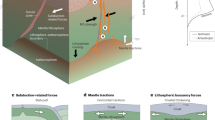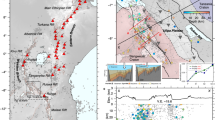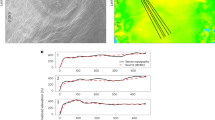Abstract
Constraints on the structure of rifted continental margins and the magmatism resulting from such rifting can help refine our understanding of the strength of the lithosphere, the state of the underlying mantle and the transition from rifting to seafloor spreading. An important structural classification of rifts is by width1, with narrow rifts thought to form as necking instabilities2 (where extension rates outpace thermal diffusion3) and wide rifts thought to require a mechanism to inhibit localization, such as lower-crustal flow in high heat-flow settings1,4. Observations of the magmatism that results from rifting range from volcanic margins with two to three times the magmatism predicted from melting models5 to non-volcanic margins with almost no rift or post-rift magmatism. Such variations in magmatic activity are commonly attributed to variations in mantle temperature. Here we describe results from the PESCADOR seismic experiment in the southern Gulf of California and present crustal-scale images across three rift segments. Over short lateral distances, we observe large differences in rifting style and magmatism—from wide rifting with minor synchronous magmatism to narrow rifting in magmatically robust segments. But many of the factors believed to control structural evolution and magmatism during rifting (extension rate, mantle potential temperature and heat flow) tend to vary over larger length scales. We conclude instead that mantle depletion, rather than low mantle temperature, accounts for the observed wide, magma-poor margins, and that mantle fertility and possibly sedimentary insulation, rather than high mantle temperature, account for the observed robust rift and post-rift magmatism.
This is a preview of subscription content, access via your institution
Access options
Subscribe to this journal
Receive 51 print issues and online access
$199.00 per year
only $3.90 per issue
Buy this article
- Purchase on Springer Link
- Instant access to full article PDF
Prices may be subject to local taxes which are calculated during checkout


Similar content being viewed by others
References
Hopper, J. R. & Buck, W. R. The effect of lower crustal flow on continental extension and passive margin formation. J. Geophys. Res. 101, 21175–20194 (1996)
Braun, J. & Beaumont, C. Styles of continental rifting from dynamical models of lithospheric extension. Mem. Can. Soc. Petrol. Geol. 12, 241–258 (1987)
England, P. C. Constraints on extension of continental lithosphere. J. Geophys. Res. 88, 1145–1152 (1983)
Buck, W. R., Lavier, L. L. & Poliakov, A. N. B. How to make a rift wide. Phil. Trans. R. Soc. Lond. 357, 671–693 (1999)
McKenzie, D. & Bickle, M. J. The volume and composition of melt generated by extension of the lithosphere. J. Petrol. 29, 625–679 (1988)
Lonsdale, P. Geology and tectonic history of the Gulf of California. In The Eastern Pacific Ocean and Hawaii (eds Winterer, E. L., Hussong, D. M. & Decker, R. W.) 499–521, Vol. N of The Geology of North America (Geological Society of America, Boulder, Colorado, 1989)
Atwater, T. M. Implications of plate tectonics for the Cenozoic evolution of western North America. Geol. Soc. Am. Bull. 81, 3513–3536 (1970)
Menard, H. W. Fragmentation of the Farallon plate by pivoting subduction. J. Geol. 86, 99–110 (1978)
Stock, J. M. & Lee, J. Do microplates in subduction zones leave a geological record? Tectonics 13, 1472–1487 (1994)
Michaud, F. et al. Oceanic-ridge subduction vs. slab break off: Plate tectonic evolution along the Baja California Sur continental margin since 15 Ma. Geology 34, 13–16 (2006)
DeMets, C. & Dixon, T. H. New kinematic models for Pacific-North America motion from 3 Ma to present. I. Evidence for steady motion and biases in the NUVEL-1A model. Geophys. Res. Lett. 26, 1921–1924 (1999)
Dixon, T. H., Farina, F., DeMets, C., Suarez-Vidal, F., Fletcher, J., Marquez-Azua, B., Miller, M., Sanchez, O. & Umhoefer, P. J. New kinematic models for Pacific-North America motion from 3 Ma to present. II. Evidence for a “Baja California shear zone”. Geophys. Res. Lett. 26, 1921–1924 (2000)
Phillips, R. P. Seismic refraction studies in Gulf of California. In Marine Geology of the Gulf of California (eds van Andel, T. & Shor, G. G.) AAPG Mem.. 3, 90–125 (1964)
González-Fernández, A. et al. Mode of extension and rifting history of upper Tiburón and upper Delfín basins, northern Gulf of California. J. Geophys. Res. 110 doi: 10.1029/2003JB002941 (2005)
Sutherland, F. H. Continental Rifting Across the Southern Gulf of California. PhD thesis, Univ. of California, San Diego. (2006)
Paramo, P. Seismic Studies of Continental Rupture and Ocean Finestructure in the Gulf of California. PhD thesis, Univ. of Wyoming. (2006)
Brown, H. E. et al. Crustal structure of the southern Gulf of California and subducting Rivera plate. Eos 87 (Fall Meet. Suppl.). T41D–1607 (2006)
Castillo, P. R. et al. Petrology of Alarcon Rise lavas, Gulf of California: Nascent intracontinental ocean crust. J. Geophys. Res. 107 doi: 10.1029/2001JB000666 (2002)
Buck, W. R. The role of magma in development of the Afro-Arabian rift system. In The Afar Volcanic Province Within the East African Rift System (eds Yirgu, G., Ebinger, C. J. & Maguire, P. K. H.) Geol.. Soc. Spec. Publ. 259, 43–54 (2006)
Larsen, R. L. Bathymetry, magnetic anomalies, and plate tectonic history of the mouth of the Gulf of California. Geol. Soc. Am. Bull. 83, 3345–3360 (1972)
Ferrari, L., Valencia-Moreno, M. & Bryan, S. Magmatismo y tectónica en la Sierra Madre Occidental y su relación con la evolución de la margen occidental de Norteamérica. Bull. Geol. Soc. Mexico 57, 343–378 (2005)
Hirth, G. & Kohlstedt, D. L. Water in the oceanic upper mantle: Implications for rheology, melt extraction, and the evolution of the lithosphere. Earth Planet. Sci. Lett. 144, 93–108 (1996)
White, R. S., McKenzie, D. & O’Nions, R. K. Oceanic crustal thickness from seismic measurements and rare earth element inversions. J. Geophys. Res. 97, 19,683–19,715 (1992)
Einsele, G. et al. Intrusion of basaltic sills into highly porous sediments, and resulting hydrothermal activity. Nature 283, 441–445 (1980)
Batiza, R. Geology, petrology, and geochemistry of Isla Tortuga, a recently formed tholeiitic island in the Gulf of California. Geol. Soc. Am. Bull. 89, 1309–1324 (1978)
Humphreys, E. et al. How Laramide-age hydration of North American lithosphere by the Farallon slab controlled subsequent activity in the western United States. Int. Geol. Rev. 45, 575–595 (2003)
Oskin, M., Stock, J. M. & Martín-Barajas, A. Rapid localization of Pacific-North America plate motion in the Gulf of California. Geology 29, 459–462 (2001)
Brown, J. W. & White, R. S. Effect of finite extension rate on melt generation at rifted continental margins. J. Geophys. Res. 100, 18,011–18,029 (1995)
Johnson, H. P. & Pruis, M. J. Fluxes of fluid and heat from the oceanic crustal reservoir. Earth. Planet. Sci. Lett. 216, 565–574 (2003)
Zelt, C. A. & Smith, R. B. Seismic traveltime inversion for 2-D crustal velocity structure. Geophys. J. Int. 108, 16–34 (1992)
Acknowledgements
We thank the captains and crew of the RV Maurice Ewing and RV New Horizon, the OBSIP teams, J. Urban, and A. Gorman for his efforts as Chief Scientist on the RV New Horizon. The Lamont Earth Observatory Marine Office and CICESE provided support before and during the experiment. This work was funded by a grant from the US NSF-MARGINS programme.
Author Contributions D.L., P.J.U., G.M.K., W.S.H., A.J.H., A.G.-F., J.M.F. and G.J.A. were the principal investigators on this project and each contributed substantially to this work. F.S., P.P. and H.E.B. analysed data from the Alarcón and Cabo–PV segments as portions of their PhD theses. D.L. analysed data from Guaymas and wrote the paper. All authors discussed the results and commented on the manuscript.
Author information
Authors and Affiliations
Corresponding author
Ethics declarations
Competing interests
Reprints and permissions information is available at www.nature.com/reprints. The authors declare no competing financial interests.
Supplementary information
Supplementary Information
This file contains Supplementary Notes, Supplementary Figures S1-S7 with Legends and additional references. (PDF 3546 kb)
Rights and permissions
About this article
Cite this article
Lizarralde, D., Axen, G., Brown, H. et al. Variation in styles of rifting in the Gulf of California. Nature 448, 466–469 (2007). https://doi.org/10.1038/nature06035
Received:
Accepted:
Issue Date:
DOI: https://doi.org/10.1038/nature06035
This article is cited by
-
Towards a process-based understanding of rifted continental margins
Nature Reviews Earth & Environment (2023)
-
P- and S-wave attenuation in the northern region of the Gulf of California, Mexico
Journal of Seismology (2023)
-
Microbial communities of Auka hydrothermal sediments shed light on vent biogeography and the evolutionary history of thermophily
The ISME Journal (2022)
-
Detailed Regional Magnetic Mapping on a Bike, A Case Study from Northern Israel
Pure and Applied Geophysics (2022)
-
Melt volume at Atlantic volcanic rifted margins controlled by depth-dependent extension and mantle temperature
Nature Communications (2021)
Comments
By submitting a comment you agree to abide by our Terms and Community Guidelines. If you find something abusive or that does not comply with our terms or guidelines please flag it as inappropriate.



